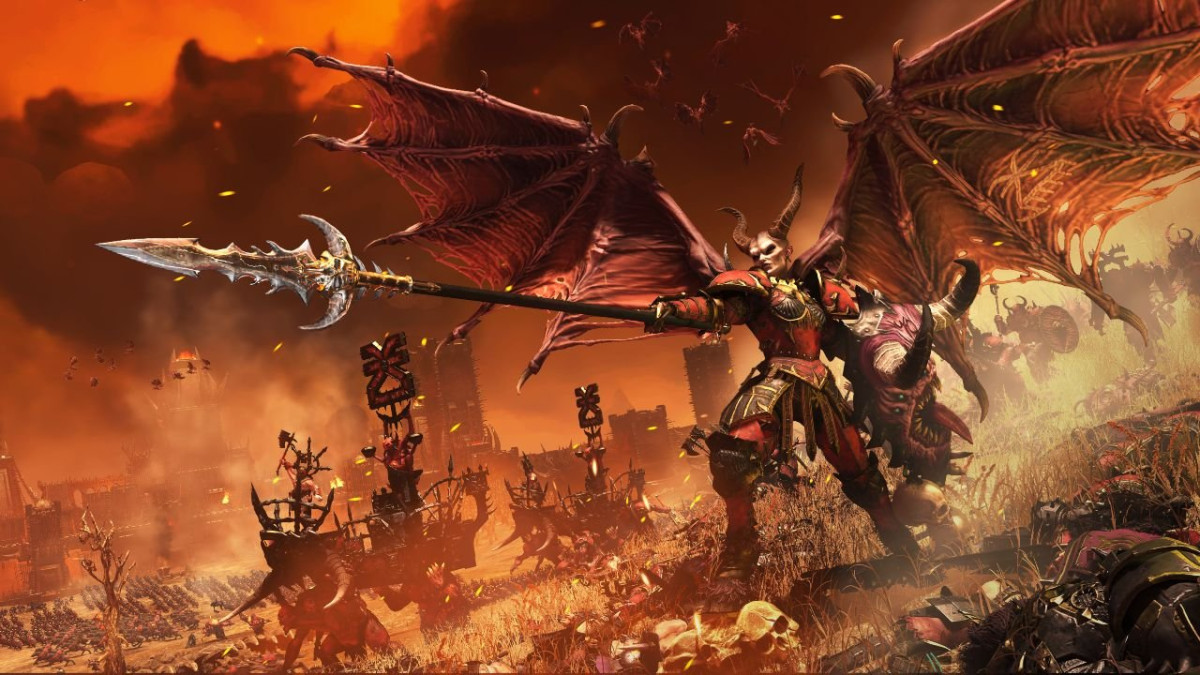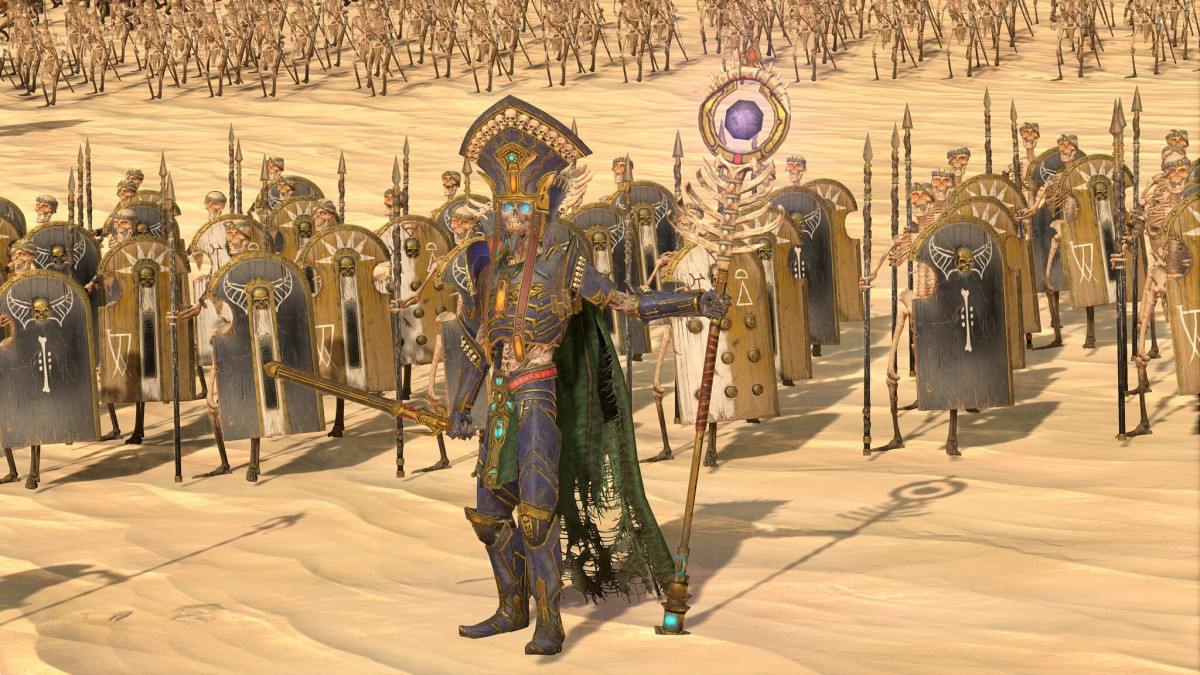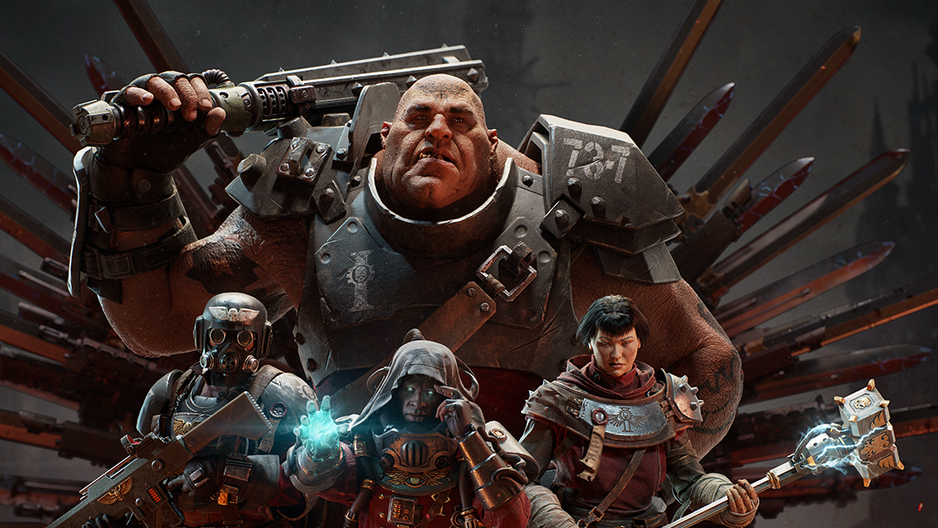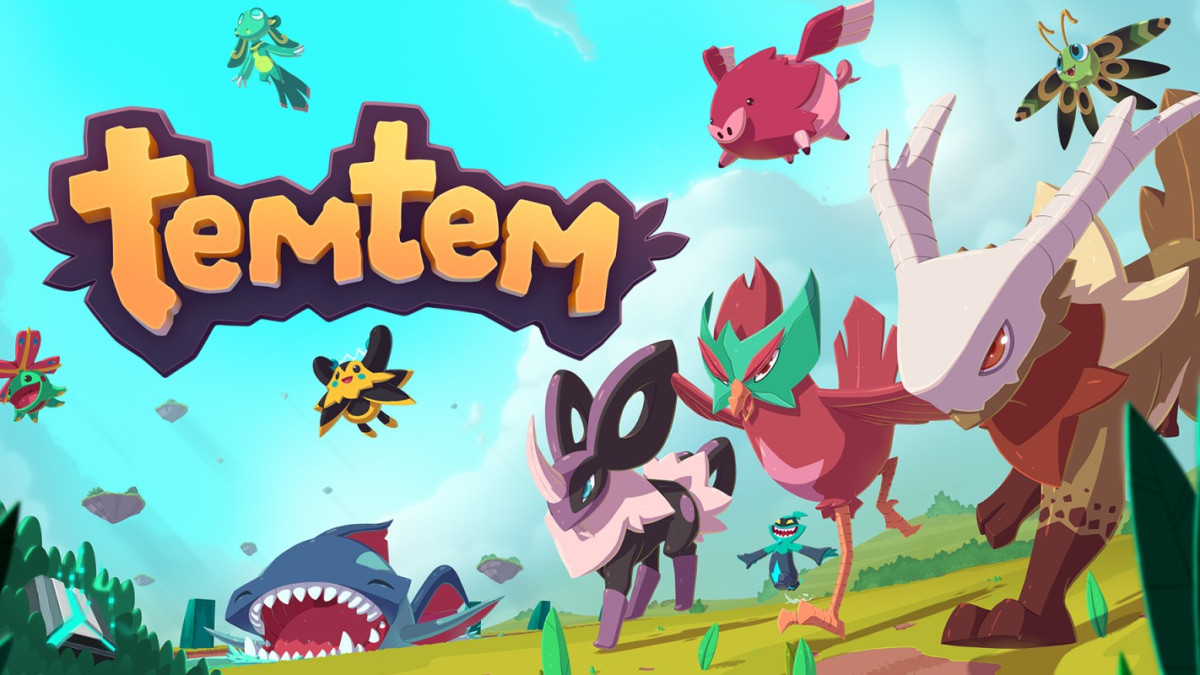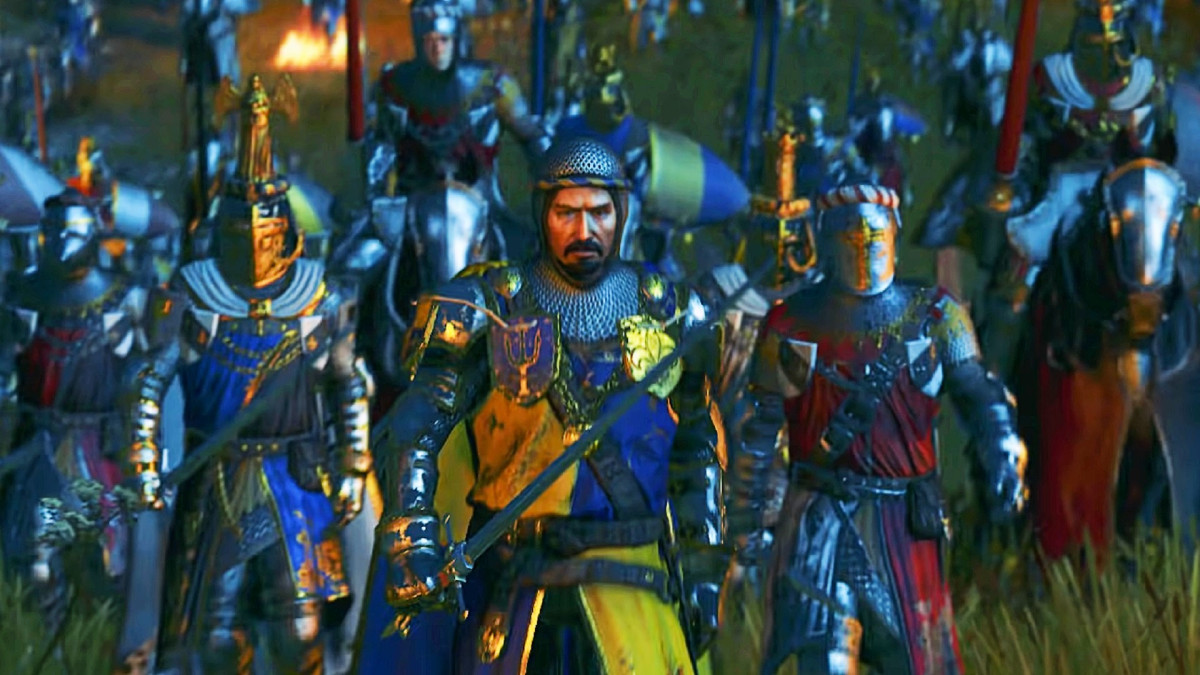
Beginner's Guide to Bretonnia in Total War: Warhammer III
Table of Contents
Bretonnia can be a confusing faction to play as at times. In the past I have spoken to players of Total War: Warhammer III who tried the faction but always felt like they were really weak, or that they couldn't build good armies because the units are too expensive. In most of these cases it turned out that they'd completely missed one of the "extra" things that Bretonnia players have to manage to get the most out of the faction.
This guide will explain the basics of Bretonnia and how to utilize their strengths.
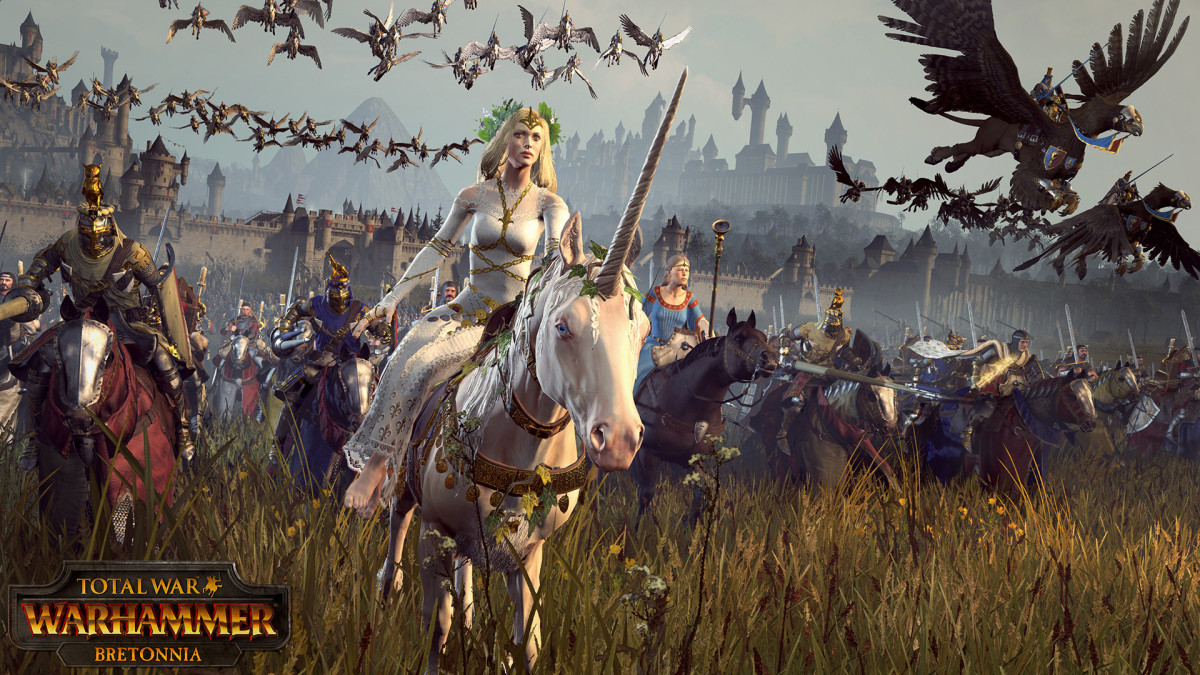
Bretonnian Strengths & Weaknesses Explained
One of the most important things to learn about a faction in any strategy game is their strengths and weaknesses. Once you understand those you can begin planning how to maximise the former and minimise the latter.
On the campaign map, Bretonnia has some key advantages:
The first of these is their economy - it is actually very strong, its farm buildings give probably the best return on investment from any economic building in the entire game. I'll explain this more later in the guide.
As for their battle strength, their infantry is admittedly some of the worst in the game. You can get some decent results from the Peasant Archers, but this is harder than it was in Warhammer II due to a blanket nerf to missile DPS across the game.
On the other hand, Bretonnia easily has the best cavalry roster in the game, including "Monstrous Flying Cavalry" in the shape of Royal Hippogryph Knights, a unit that certainly has doomstack potential. Its lords and heroes are also strong, and leaning on them in the early game when you haven't unlocked your strong units yet is a good idea.

On a side note, Bretonnia's geography can be both a blessing and a curse. Most Bretonnian factions are clustered close together in the Bretonnian homeland, and they can be confederated very quickly via the technology tree, allowing for fast and easy expansion if you want to do that. However, Bretonnia is also surrounded by powerful enemies - Norsca and Chaos forces marauding from the north, Orcs and Vampires in the mountains, and Clan Skryre in the south. It's also not impossible that Reikland and the Wood Elves of Athel Loren will also decide that they don't like you - especially on higher difficulties.
Bretonnian Vow System Explained
Bretonnia has several unique campaign mechanics, and one of these is the Vows system.
Vows are a set of challenges that Lords and Heroes need to complete in order to unlock additional bonuses. Lords will also get massive upkeep penalties on any knight units they recruit if they haven't completed the Vow associated with that unit.
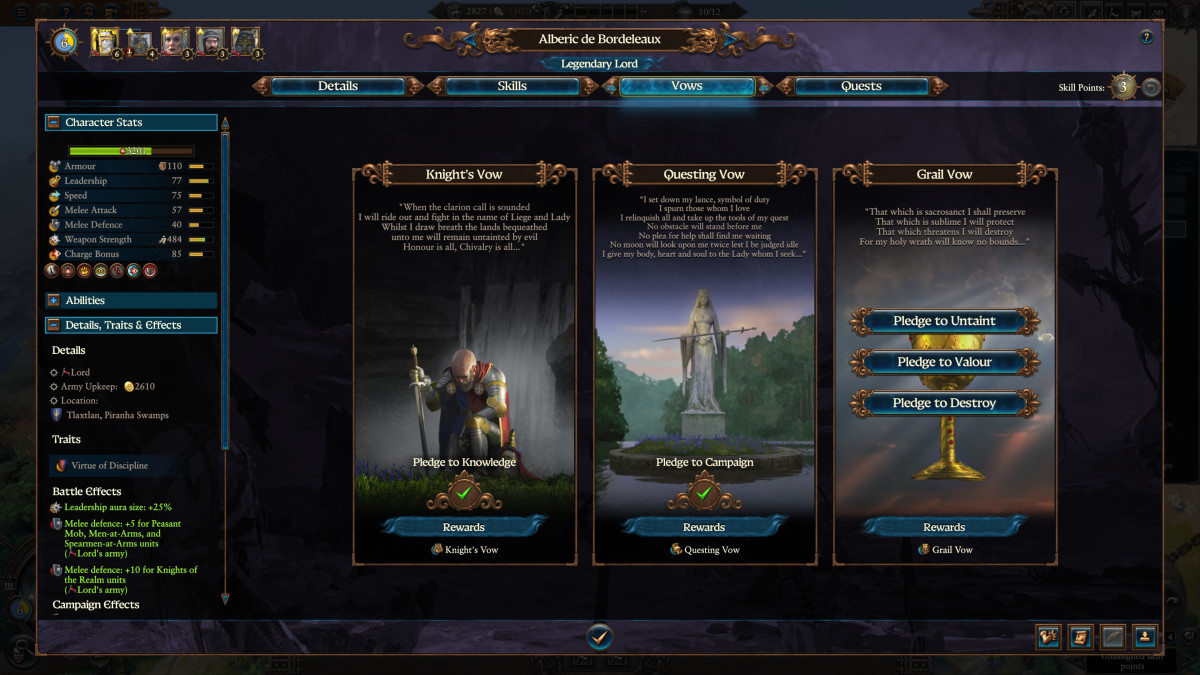
Legendary Lords generally start the game with at least one of the Vows unlocked, but other characters will need to start from scratch, at least to begin with. When you reach certain Chivalry thresholds, new recruits will immediately have some Vows unlocked.
It's very important to immediately select a Pledge on any Lords and Heroes you have at the start of the game, and on every character that you recruit later on. Not completing the Vows will cause problems later in the campaign, because you will be unable to field the best units in Bretonnia's roster.
Knight's Vow
The Knight's Vow (Called Troth of Protection for Prophetess Lords) is the first Vow that characters need to complete. The easiest Pledge to take is the Pledge to Chivalry, which just requires the character to rank up 5 times.
Upon finishing the Knight's Vow, Lords will gain -3 Local Corruption, +25% Leadership Aura Size, and the ability to field Knights Errant, Knights of the Realm and Pegasus Knights without upkeep penalties. Heroes will get an extra +5 Armour and Leadership.
Questing Vow
The Questing Vow (called Troth of Wisdom for Prophetesses) is the second Vow. It's the most annoying one to get, as none of the Pledges are easy to complete in most scenarios, and its sometimes better to just wait until an opportunity arises to complete one of the pledges, rather than immediately choosing one and being stuck with it.
That said, if you are playing as Alberic de Bordelaux or Repanse de Lyonesse, the Pledge to Campaign should be pretty easy to complete - you have to win a siege battle (this means a walled settlement) in a Desert of Jungle, and those characters are surrounded by such climes.
For everyone else though, you might need to use one of the other Pledges - either the Pledge to Manann (Win a battle at sea) or the Pledge to Protect (defeat an Ogre, Beastmen, Dark Elf or Greenskin Legendary Lord).
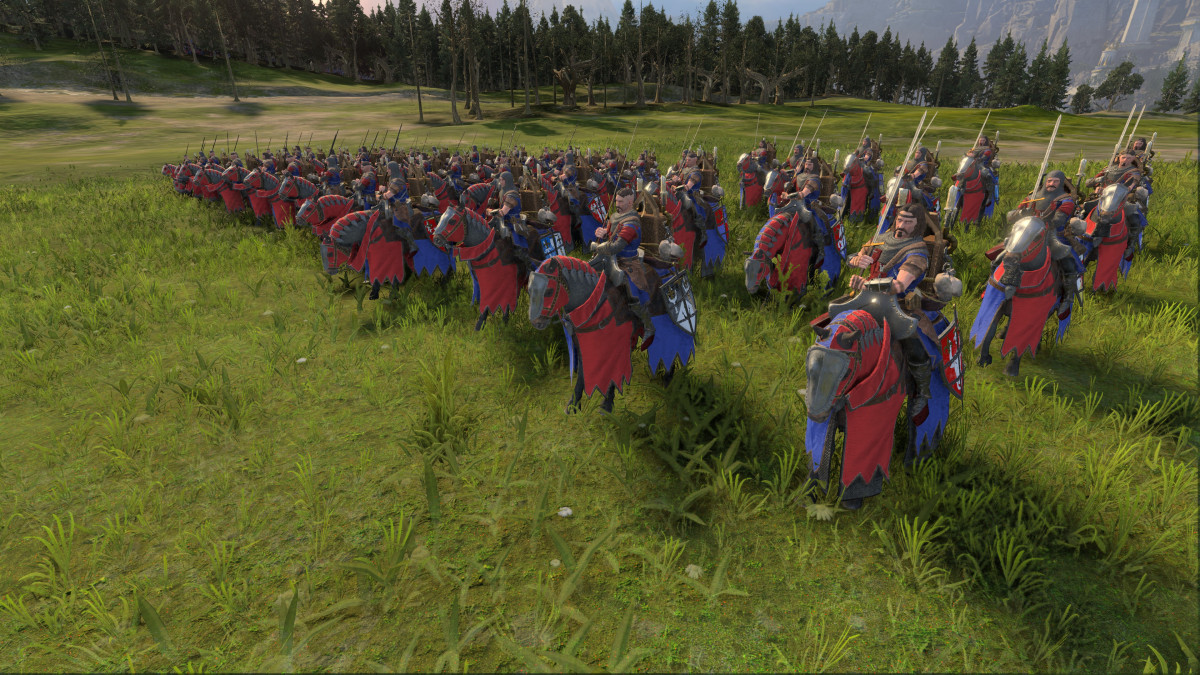
For melee Lords, the Questing Vow Gives +10% Campaign Movement Range, +10% Weapon Strength and the ability to field Questing Knights without upkeep penalties.
For Prophetesses, it gives +10% Winds of Magic Power Reserve Change, but otherwise the same benefits.
For Paladin Heroes, it gives +5 to melee attack and defence.
Grail Vow
The Grail Vow (or Troth of Virtue for Prophetesses) is the third and final Vow. It's generally quite easy to get this one if you choose the Pledge to Valour, which just requires the army that your Lord or Hero is in to kill five enemy Lords in battle. As usual though there are two other options.
You can instead choose Pledge to Untaint, which requires you to defeat a Legendary Lord of Warriors of Chaos, Daemons of Chaos, Skaven, Vampire Counts or Vampire Coast. If one of these happens to be nearby, then choosing this may be faster than Pledge to Valour.
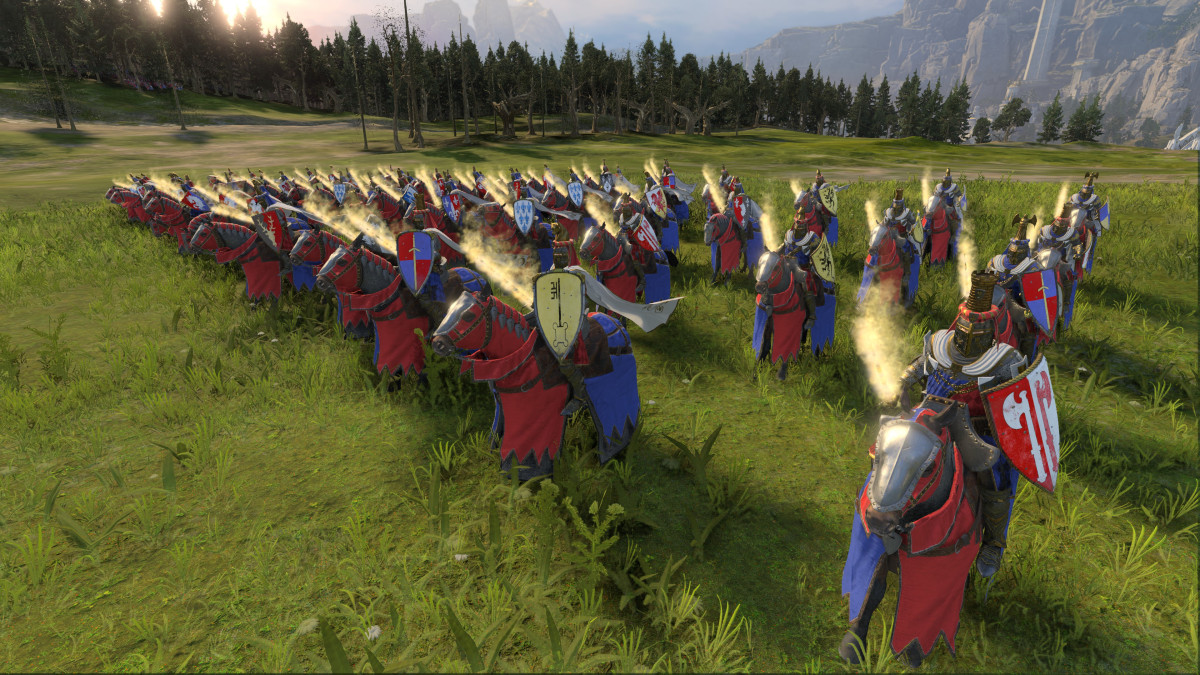
Finally, there is the Pledge to Destroy, which requires you to raze five settlements. I rarely find myself razing settlements as Bretonnia, but if that's something you enjoy doing then that's an option.
The Grail Vow will make the character immortal if they aren't already. Lords will get -1 Wound Recovery Time, Perfect Vigour and Magical Attacks, along with the ability to field all of Bretonnia's units without upkeep penalties. For Heroes it will give Perfect Vigour (immune to becoming tired) and Magical Attacks.
Bretonnian Peasant Economy Mechanic Explained
The Peasant Economy is a fairly simple mechanic that Bretonnia has. The idea is that peasants make up the backbone of their farming economy, and levying too many of them into your army makes your farms less efficient. You will have a Peasant unit limit shown at the top right of the screen, and recruiting more peasant units than this limit will cause your farms to make less money.
If you stay within the limit however, Peasant Mob units will be free of upkeep, and other peasant units will be 10% cheaper.

If you're wondering what qualifies as a peasant units, this means basically anything that isn't a Knight, including Field Trebuchets and the "elite" infantry unit of Bretonnia, the Foot Squires.
Your capital settlement provides you with 8 peasant capacity, and every additional settlement you own will give you another 2.
Bretonnian Chivalry Mechanic Explained
The final mechanic that's unique to Bretonnia is Chivalry. Chivalry is kind of like a currency, except that there aren't many ways to spend it, so maybe its better to just call it a rating of how virtuous your actions have been over the course of a campaign.
Winning battles will increase your chivalry score, as will some other actions such as razing settlements belonging to hostile races. Ransoming captives and sacking settlements will reduce your Chivalry. There are also some traits that can increase or decrease your chivalry.

But why does any of this matter? Chivalry isn't just a score, it also gives you pretty powerful benefits for reaching certain thresholds. These are listed below:
- Noble, 0 - 1,999 Chivalry - +2 Leadership for all armies
- Honourable, 2,000 - 3,999 Chivalry - You may call upon the Green Knight. +1 Recruit Rank for all Knight units. +4 Leadership for all armies.
- Knightly, 4,000 - 5,999 Chivalry - You may call upon the Green Knight again. All Lords start with the Knight's Vow. Lord Recruit Rank +1. +2 Recruit Rank for Knight units. +6 Leadership for all armies.
- Virtuous, 6,000 to 7,999 Chivalry - You may call upon the Green Knight again. All Lords start with the Knight's Vow. +3 Lord Recruit Rank. -1 Corruption in all provinces. Recruit rank +3 for Knight units. +8 Leadership for all armies.
- Chivalrous, 8,000 - 10,000 Chivalry - You may call upon the Green Knight Limitless times. All Lords start with the Questing Vow. All units gain 100 experience per turn. +5 Lord Recruit Rank. -2 Corruption in all provinces. +4 Recruit rank for Knight units. +10 Leadership for all armies.
You might be wondering who on earth the Green Knight is. He is basically an extra hero you can summon and attach to your armies. He's a pretty good fighter, and he's a ghost so he has high resistance to physical attacks and will frighten enemy units. Unlike normal heroes though he can't be levelled up and doesn't have a skill tree.
One of the main ways that Chivalry can be "spent" is by completing the Heraldry technologies and opting to use some of your Chivalry to immediately confederate another Bretonnian faction. You can choose to spend your gold instead though.
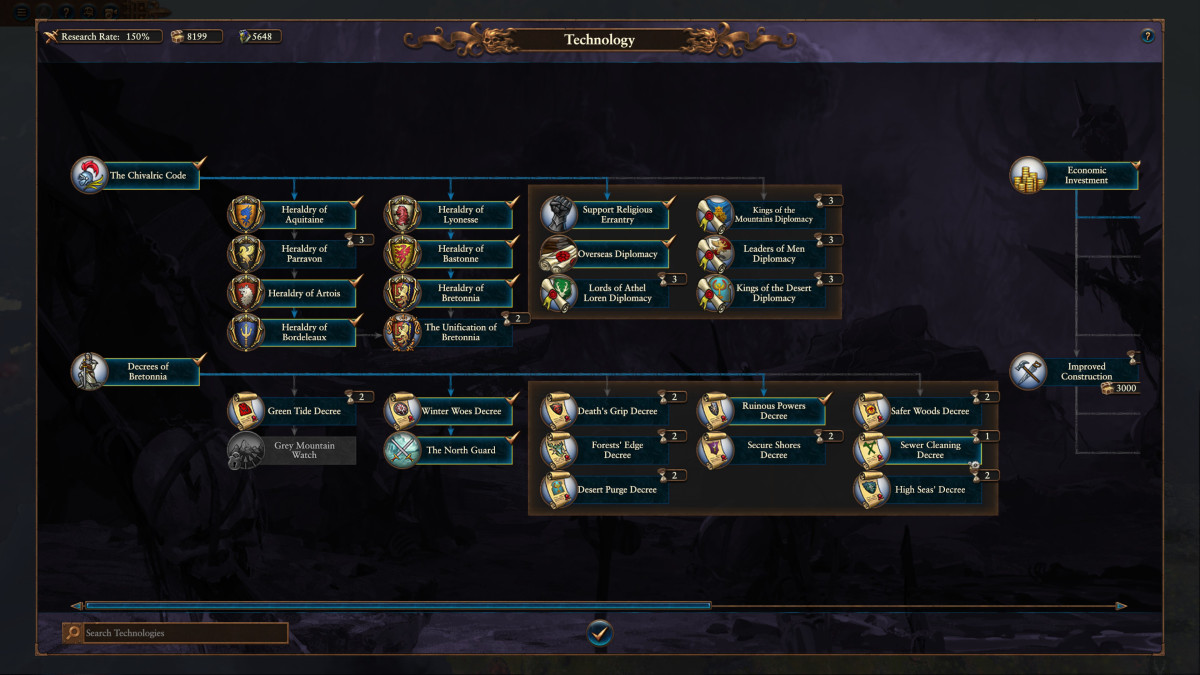
Bretonnia Economy Basics
As I mentioned earlier, Bretonnia has one of the best economies in the game, and this is entirely down to their farming buildings. The basic Fields building only costs 500 gold to build (in green climate regions), and makes 300 gold per turn. This means it only takes three turns for these to start making a profit. By focusing on farms, Bretonnia can expand its economic base faster than pretty much any faction.
I recommend focusing on the farm buildings in almost all scenarios, and ignoring the industry buildings. Remember that you have to choose between farming or industry in each province, building both will end up reducing your income as you upgrade them.
As you level up your settlements, build the windmill building to unlock upgrades for your farms. These will also provide some extra growth and up to 50% bonus income from the accompanying farm building.
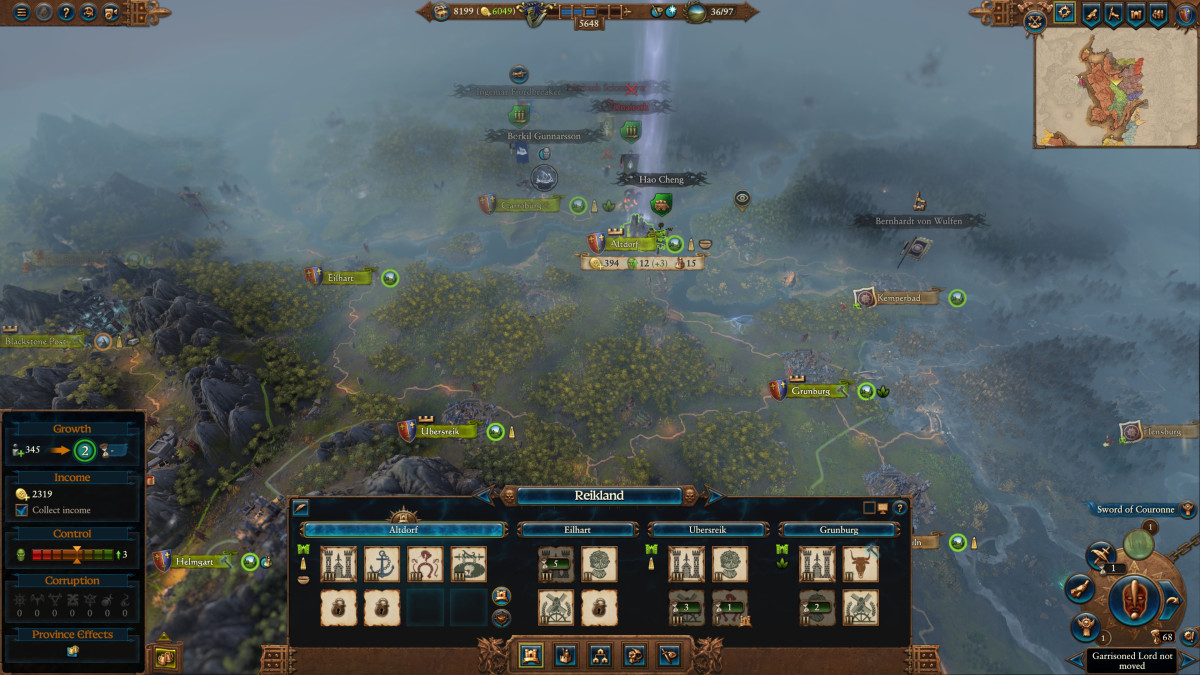
Expanding too quickly can often be ruinous in Total War: Warhammer, because you encounter more enemies before you have the economy required to support the multiple armies required to fight them all off, however Bretonnia can manage quick expansion easier than most factions due to its ability to quickly make new conquests profitable. But this only applies if you can manage Bretonnia's biggest problem, which is its weak early game military strength.
Bretonnia Early-Game Survival Tips
There are two very important things about Bretonnia that you should know:
- While their early game units are weak, their lords and heroes are strong and can really carry you through the early stages of the campaign.
- Bretonnia is completely exempt from Supply Lines penalties, which means they do not get the usual global upkeep penalty from fielding multiple armies.
With both of these things in mind, one of the first things I recommend doing is to recruit 3 additional lords to follow your starting army around the campaign map. Recruit two melee Lords and a Prophetess of Life, unless you are playing as the Fay Enchantress, then just get three melee Lords.
The melee lords can do a decent amount of damage on their own, but more importantly they can tie down large amounts of enemy units, buying time for your archers (and trebuchets, if you have them) to dish out damage.
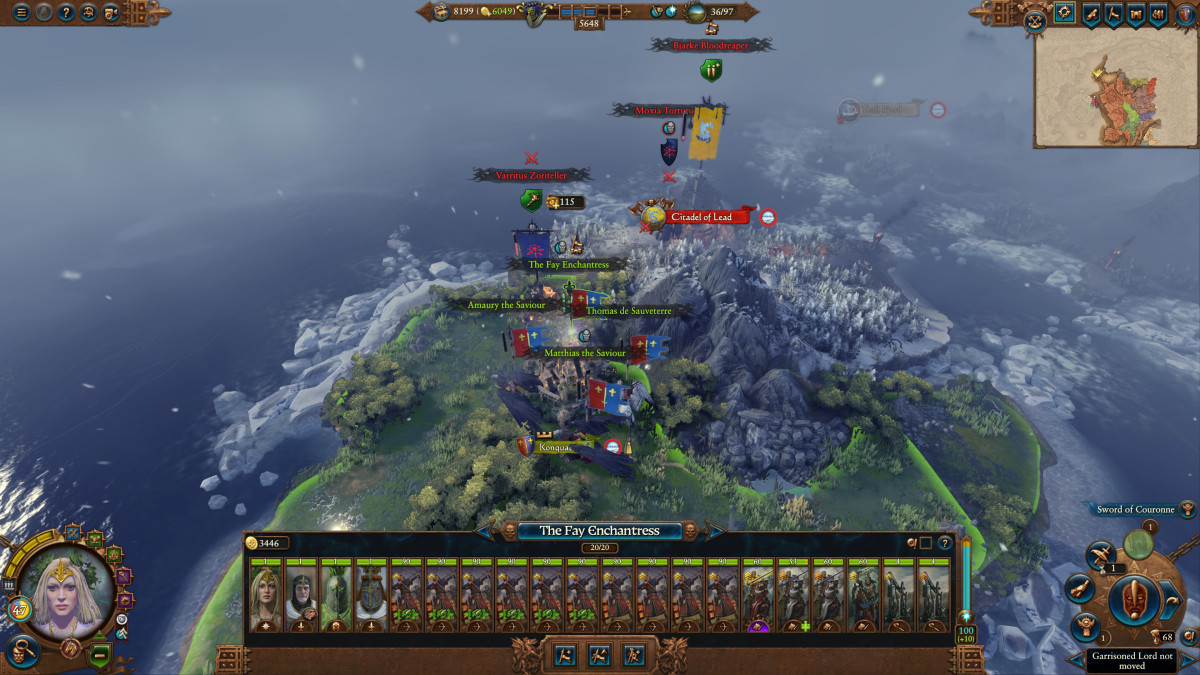
This strategy also helps Bretonnia a lot on the Campaign map - if multiple armies are involved in a battle victory, then you will earn more Chivalry for the battle. So having four armies rather than one helps to gain large amounts of Chivalry in the game and unlock the bonuses associated with that.
When moving around the campaign map, make sure these four armies stay in reinforcement range of one another.
There's just two weaknesses to doing this that you need to watch out for:
- Do not do this against Skaven, or any other faction that can ambush armies when attacking, or against a Lord that you know has level 3 Lightning Strike unlocked. They will be able to deny your ability to reinforce, so your three accompanying lords will get cut off and wounded/killed.
- Be careful if you garrison your main army in a settlement when enemies are nearby. They can send one army to besiege the settlement, stopping your main army from reinforcing the accompanying lords, and then use a second army to attack them and easily defeat them.
You can keep doing this tactic even when you've unlocked better units later in the game, other than those two points there's really no drawback to it.
I also recommend prioritizing leveling up the magic of your Life Prophetess (or the Fay Enchantress), because the spell The Dwellers Below is extremely powerful and will simply delete infantry and cavalry units that are blobbed up around your melee characters.
I hope that you will find some of these tips helpful the next time you decide to give Bretonnia a try in Total War: Warhammer III.
